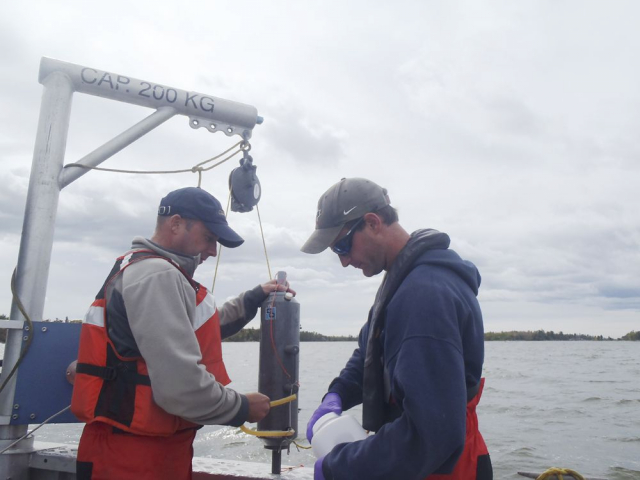 Tim Pascoe and Jeff Hanna of ECCC collect a water sample using a Niskin Sampler.Last week, I introduced some of the work that Environment and Climate Change Canada (ECCC) is doing in the Rainy – Lake of the Woods basin to provide a bit of an overview of the program with a focus on its satellite algae-tracking project. This week, the focus is on the baseline monitoring that ECCC has been doing over the course of the past 10 years.
Tim Pascoe and Jeff Hanna of ECCC collect a water sample using a Niskin Sampler.Last week, I introduced some of the work that Environment and Climate Change Canada (ECCC) is doing in the Rainy – Lake of the Woods basin to provide a bit of an overview of the program with a focus on its satellite algae-tracking project. This week, the focus is on the baseline monitoring that ECCC has been doing over the course of the past 10 years.
Since 2009, ECCC has been conducting two main baseline monitoring projects. One is collecting water quality information at 25-30 stations throughout Lake of the Woods in the spring and late summer, and the second at four key points along the Rainy River; biweekly in the ice-free period, and monthly through the ice. At these sites, ECCC is measuring nutrients, trace metals, sediment chemistry, and biological indicators that help to understand ecosystem health (chlorophyll-a, benthic invertebrates). ECCC also used to monitor mercury in water in the Rainy River, but samples were routinely below detection levels or below established guidelines, so they no longer monitor it.
An automated water sampler is also located on the Pinewood River (tributary to the Rainy River) and collects samples four times a day, every day, during ice-free conditions. The benefit of the automated sampler is that it can capture data during storm events (which is not typically when a sampler can get out), and studies have shown that these events are often when the biggest source of nutrient loadings to a waterbody occur. The Pinewood River location was selected for two reasons; the watershed is representative of agricultural areas in the southern basin, and there is significant mining development in the headwaters. Data from the Pinewood River station are also contributing to a larger monitoring network, lead by Trent University and ECCC, to develop nutrient loads for all tributaries on the Canadian side of Lake of the Woods.
So far, what the data are telling us is:
- Long term nutrient (phosphorus) levels are declining in the Rainy River;
- Iron concentrations in the Rainy River exceed guidelines, and may play a role in how nutrients are cycled in Lake of the Woods;
- Some metals exceed guidelines in the sediments of Lake of the Woods;
- Mercury in the waters of Rainy River has been found to be below guidelines of any agency, but mercury in fish tissue is elevated on Rainy River and Lake of the Woods, high enough to require fish consumption advisories; and
- There has been little to no detection of pesticides or herbicides on Lake of the Woods.
The overall goal of these monitoring programs is to provide baseline information against which the effectiveness of management actions can be measured, and to track environmental changes over the long term.
This series is provided as part of the International Watershed Coordination Program of the Lake of the Woods Water Sustainability Foundation (www.lowwsf.com).
Kelli Saunders, M.Sc., is the International Watershed Coordinator with the Lake of the Woods Water Sustainability Foundation.
